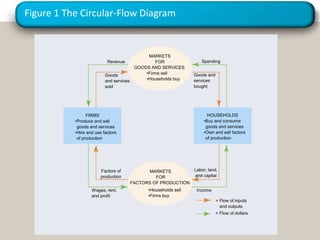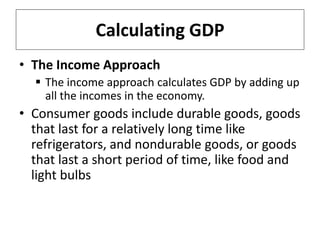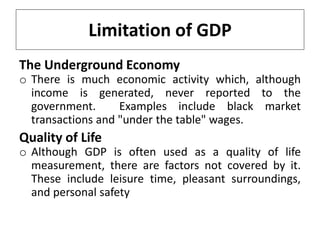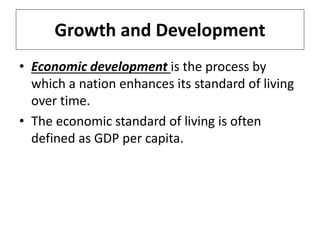Gross domestic product
- 2. Measuring a Nation’s Income • Microeconomics Microeconomics is the study of how individual households and firms make decisions and how they interact with one another in markets. • Macroeconomics Macroeconomics is the study of the economy as a whole. Its goal is to explain the economic changes that affect many households, firms, and markets at once.
- 3. Measuring a Nation’s Income • Macroeconomics answers questions like the following: Why is average income high in some countries and low in others? Why do prices rise rapidly in some time periods while they are more stable in others? Why do production and employment expand in some years and contract in others?
- 4. THE ECONOMY’S INCOME AND EXPENDITURE • When judging whether the economy is doing well or poorly, it is natural to look at the total income that everyone in the economy is earning. • For an economy as a whole, income must equal expenditure because: Every transaction has a buyer and a seller. Every dollar of spending by some buyer is a dollar of income for some seller.
- 5. Gross Domestic Product (GDP) • Gross domestic product (GDP) is a measure of the income and expenditures of an economy. • It is the total market value of all final goods and services produced within a country in a given period of time. • GDP does not include the value of intermediate goods. Intermediate goods are goods used in the production of final goods and services
- 6. Figure 1 The Circular-Flow Diagram Spending Goods and services bought Revenue Goods and services sold Labor, land, and capital Income = Flow of inputs and outputs = Flow of dollars Factors of production Wages, rent, and profit FIRMS •Produce and sell goods and services •Hire and use factors of production •Buy and consume goods and services •Own and sell factors of production HOUSEHOLDS •Households sell •Firms buy MARKETS FOR FACTORS OF PRODUCTION •Firms sell •Households buy MARKETS FOR GOODS AND SERVICES
- 7. THE COMPONENTS OF GDP • GDP includes all items produced in the economy and sold legally in markets. • What Is Not Counted in GDP? GDP excludes most items that are produced and consumed at home and that never enter the marketplace. It excludes items produced and sold illicitly, such as illegal drugs.
- 8. THE COMPONENTS OF GDP • GDP (Y) is the sum of the following: Consumption (C) Investment (I) Government Purchases (G) Net Exports (NX) Y = C + I + G + NX
- 9. THE COMPONENTS OF GDP • Consumption (C): The spending by households on goods and services, with the exception of purchases of new housing. • Investment (I): The spending on capital equipment, inventories, and structures, including new housing.
- 10. THE COMPONENTS OF GDP • Government Purchases (G): The spending on goods and services by local, state, and federal governments. Does not include transfer payments because they are not made in exchange for currently produced goods or services. • Net Exports (NX): Exports minus imports.
- 11. Calculating GDP • The Expenditure Approach The expenditure approach totals annual expenditures on four categories of final goods or services. Consumer Goods and Services Business Goods and Services Government Goods and Services Net Exports or imports of Goods and services
- 12. Calculating GDP • The Income Approach The income approach calculates GDP by adding up all the incomes in the economy. • Consumer goods include durable goods, goods that last for a relatively long time like refrigerators, and nondurable goods, or goods that last a short period of time, like food and light bulbs
- 13. REAL VERSUS NOMINAL GDP • Nominal GDP values the production of goods and services at current prices. • Real GDP values the production of goods and services at constant prices. • An accurate view of the economy requires adjusting nominal to real GDP by using the GDP deflator.
- 14. GDP DEFLATOR • The GDP deflator is a measure of the price level calculated as the ratio of nominal GDP to real GDP times 100. • It tells us the rise in nominal GDP that is attributable to a rise in prices rather than a rise in the quantities produced.
- 15. GDP DEFLATOR • The GDP deflator is calculated as follows: GDP deflator = Nominal GDP Real GDP 100
- 16. GDP DEFLATOR • Converting Nominal GDP to Real GDP Nominal GDP is converted to real GDP as follows: Real GDP Nominal GDP GDP deflator 20XX 20XX 20XX 100
- 17. GDP AND ECONOMIC WELL-BEING • Higher GDP per person indicates a higher standard of living. • GDP is not a perfect measure of the happiness or quality of life, however.
- 18. GDP AND ECONOMIC WELL-BEING • Some things that contribute to well-being are not included in GDP. The value of leisure. The value of a clean environment. The value of almost all activity that takes place outside of markets, such as the value of the time parents spend with their children and the value of volunteer work.
- 19. Limitation of GDP • GDP does not take into account certain economic activities, such as: Nonmarket Activities o GDP does not measure goods and services that people make or do themselves, such as caring for children, mowing lawns, or cooking dinner. Negative Externalities o Unintended economic side effects, such as pollution, have a monetary value that is often not reflected in GDP.
- 20. Limitation of GDP The Underground Economy o There is much economic activity which, although income is generated, never reported to the government. Examples include black market transactions and "under the table" wages. Quality of Life o Although GDP is often used as a quality of life measurement, there are factors not covered by it. These include leisure time, pleasant surroundings, and personal safety
- 21. Factors Influencing GDP Aggregate Supply • Aggregate supply is the total amount of goods and services in the economy available at all possible price levels. • As price levels rise, aggregate supply rises and real GDP increases. Aggregate Demand • Aggregate demand is the amount of goods and services that will be purchased at all possible price levels. • Lower price levels will increase aggregate demand as consumers’ purchasing power increases. Aggregate Supply/Aggregate Demand Equilibrium By combining aggregate supply curves and aggregate demand curves, equilibrium for the macroeconomy can be determined.
- 22. Growth Rate of GDP • The GDP growth rate measures how fast the economy is growing. • It does this by comparing one quarter of the country's economic output (Gross Domestic Product) to the last. • The GDP growth rate is driven by the four components of GDP.
- 23. Growth Rate of GDP • GDP growth is personal consumption, which includes retail sales. GDP growth is also driven by business investment, which includes construction and inventory levels. • Government spending is another driver of growth, and is sometimes necessary to jumpstart the economy after a recession.
- 24. Growth Rate of GDP • Last, but not least, are exports and imports. Exports drive growth, but increases in imports have a negative impact.
- 25. Per Capita GDP • A measure of the total output of a country that takes the gross domestic product (GDP) and divides it by the number of people in the country. • The per capita GDP is especially useful when comparing one country to another because it shows the relative performance of the countries.
- 26. Growth and Development • Economic growth is the increase of a nation’s real output (GDP). • Results from: Greater quantities of natural resources, human resources, and capital, Improvements in the quality of resources, and Technological advances that boost productivity.
- 27. Growth and Development • Economic development is the process by which a nation enhances its standard of living over time. • The economic standard of living is often defined as GDP per capita.


























